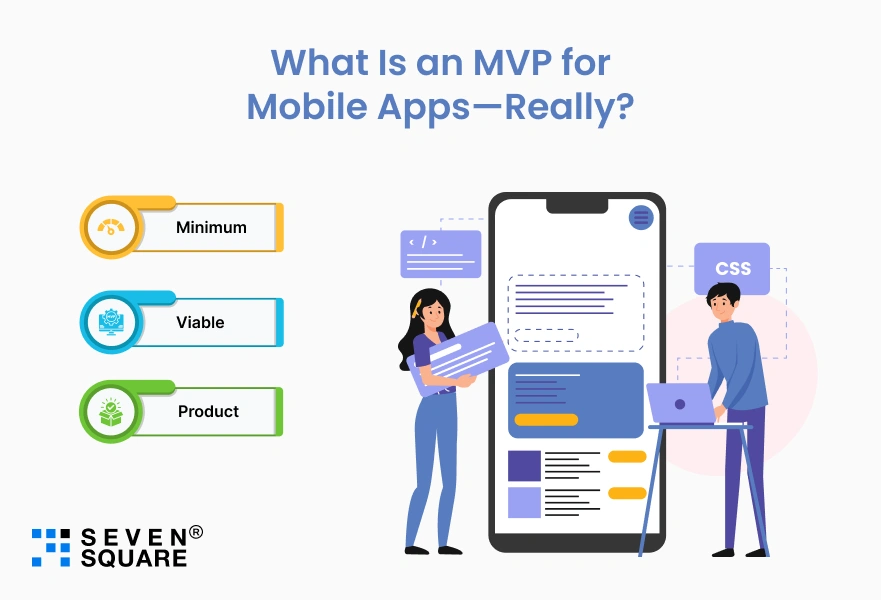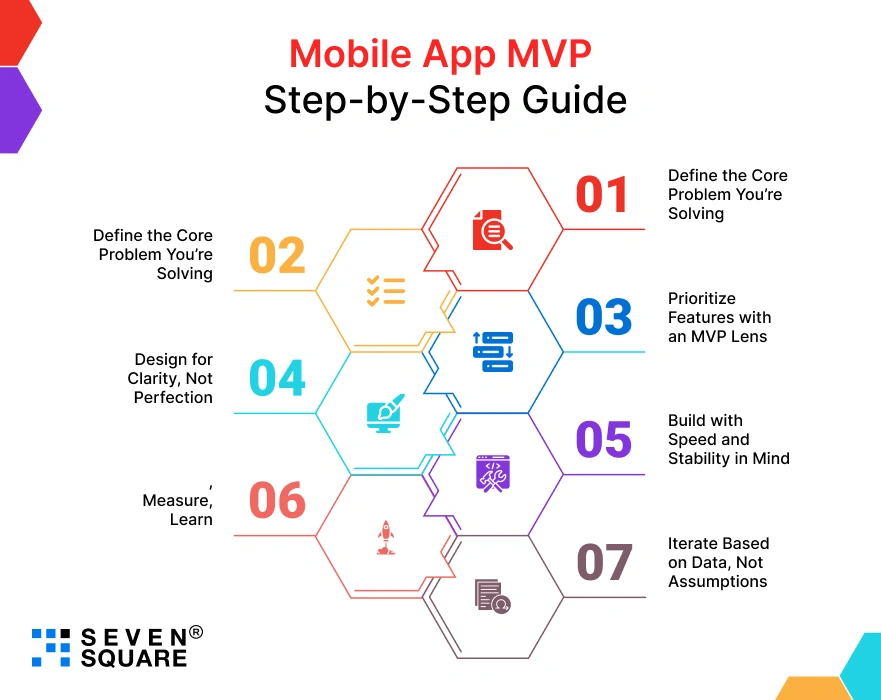You don’t need 30 features on Day One.
You don’t need a 6-month roadmap before launch.
You don’t need to wait until your app is “perfect.”
You just need a solid, usable MVP for your mobile app that solves one real problem clearly and fast.
That’s a lesson we’ve seen play out again and again with founders who come to us after burning months (and budgets) chasing a bloated vision.
And here’s the thing: They usually already had something valuable buried under the weight of “just one more feature.”
Are you trying to figure out how to build MVP for mobile apps?
In this blog, we will talk about how to build an MVP for a mobile app the right way, and why it’s one of the smartest decisions you’ll make as a founder.
The Overbuilding Trap: Why Most Founders Get It Wrong?
You’re excited. You’ve mapped your idea. You want users to love it from day one. So you pile on everything:
- Dark mode
- Referral program
- In-app chat
- Loyalty badges
- Offline support
- Multiple payment gateways
- And the list keeps growing
We get it. But here’s the uncomfortable truth:
Most of that doesn’t matter if your core feature doesn’t deliver value.
At Seven Square, we’ve provided MVP development services to founders across fintech, healthcare, media, logistics, and e-commerce.
The pattern is always the same: The teams who win early cut ruthlessly and launch fast with only the necessities.
What Is an MVP for Mobile Apps—Really?

A minimum viable product mobile app is not a “cheap” version of your idea. It’s not half-baked.
It’s the smallest version of your app that solves a core user problem well enough to test the waters.
Think of it as:
- Minimum: Lean, focused, nothing extra
- Viable: It works, it delivers value
- Product: People can use it, and they want to
MVP for mobile apps is not about the feature count of the apps. It’s about problem clarity.
Smart MVP development is all about building what users want.
Real-World Wins: Our MVP Approach in Action
We recently helped a founder build a mobile app MVP that matched medical professionals with hospitals for shift-based hiring.
The early instinct was to build a full marketplace: rating systems, map integrations, document storage, etc.
Instead, we built:
- A clean onboarding flow
- Real-time shift request matching
- One-click booking confirmation
That’s it.
They onboarded 30+ hospitals in two months. Only after that did we move to phase two based on real usage data.
The Mobile App MVP Features Checklist
Before you build anything, ask: what’s the single job this app must do for the user?
Here’s a quick checklist to trim the fat:
- Is this a must-have for the first user interaction?
- Can I launch without this feature for 30 days?
- Does this feature prove or disprove our core hypothesis?
- Does this require maintenance or a cost we can avoid for now?
Use this as your filter. Every time.
Mobile App MVP Step-by-Step Guide (With Proven Process)

If you’re wondering how to build an MVP for a mobile app, this is the framework we’ve followed at Seven Square across dozens of industries from healthcare to logistics to finance.
It’s designed to help founders and product managers go from raw ideas to testable products in the fastest, smartest way possible.
This mobile app MVP step-by-step guide will help you prioritize what matters, reduce waste, and set your app up for growth before you even think about scaling.
Here you can see the complete process for building mobile app MVP:
Step 1: Define the Core Problem You’re Solving
Every successful MVP for mobile apps starts with a clear, painful user problem. Before you write a single line of code, you need to answer:
- Who is this app for?
- What’s the one thing they need solved immediately?
- Why would they use your app over workarounds?
This phase isn’t about features, it’s about pain. If you can’t define the pain, your product will be fluff.
Tip: Use surveys, interviews, or even competitor reviews to validate your assumptions.
Step 2: Outline the Critical User Flow
Instead of designing the whole app, map just the essential user journey from app open to value delivered.
For example, if you’re building a minimum viable product mobile app for food delivery, your MVP flow might be:
- Browse nearby restaurants
- Add item to cart
- Checkout with preferred payment method
No loyalty points, no ratings, & no promo codes just the shortest path to solving the core problem.
This is the heart of MVP mobile development process: prioritize user success, not feature depth.
Step 3: Prioritize Features with an MVP Lens
Now that you have the user journey, distill it into a mobile app MVP features checklist. This should only include what’s critical to make the flow work.
Ask yourself:
- What’s the one thing this feature helps prove?
- Can we fake or simplify this for now?
- Will this feature slow down time-to-launch?
Stick to 3 to 5 core features. Remember, the best MVP for mobile apps for startups are lean and learning-focused.
Example: Instead of integrating real-time chat, use automated notifications or email alerts for v1.
Step 4: Design for Clarity, Not Perfection
You don’t need a Dribbble-worthy UI for your MVP, you need clarity. Use native components and proven UX patterns that help users complete actions quickly.
Why? Because this phase is about validating your mobile app MVP idea with users, not impressing them with visual flair.
Keep things simple:
- Use system fonts
- Stick to primary actions
- Avoid unnecessary animations
Your mobile app MVP should be frictionless and not flashy.
Step 5: Build with Speed and Stability in Mind
This is where tech choices matter smartly.
For most projects, we recommend using cross-platform frameworks like Flutter or React Native, they allow you to ship on iOS and Android fast.
During this MVP app development phase, focus on:
- Writing modular, scalable code
- Keeping integrations minimal
- Using tools you can iterate on quickly
Our team at Seven Square combines engineering discipline with product thinking, we don’t just ship fast, and we build for scale.
Step 6: Launch, Measure, Learn
Now comes the most important part: ship it. No delays. No more polish. Just get it in users’ hands.
This is where the cost to develop mobile app MVP meets real-world validation. Once users are in, track:
- Activation rate (Did they reach value?)
- Retention rate (Did they come back?)
- Conversion rate (Did they take your desired action?)
These are your mobile app MVP success metrics and they’ll tell you exactly what to do next.
Step 7: Iterate Based on Data, Not Assumptions
Launching is not the end, it’s just the start of your mobile app MVP iteration after launch.
Once you’ve gathered real data and user feedback, revisit your backlog. Now is the time to:
- Kill features that didn’t matter
- Improve what confused users
- Add only what was repeatedly requested
This is how you go from MVP to product-market fit not by guessing, but by learning.
This step-by-step approach to building your mobile app MVP helps founders launch faster, validate more intelligently, and reduce the cost of failure.
And if you need a team that knows how to do it right without overbuilding we’re here.
Founder Tips for MVP Mobile App Launch
Here are lessons we repeat to every founder we work with:
- Launch before you feel ready. Perfection is a moving target. Speed matters more.
- Track one key metric. Sign-ups? Referrals? Stickiness? Focus on one.
- Don’t build onboarding until you have something to onboard people to.
- Talk to real users. Early users > assumptions.
What’s the Cost to Develop a Mobile App MVP?
Here’s a better question: What does it cost you to overbuild?
We’ve seen MVPs go live in 3 to 5 weeks for under $5K.
We’ve also seen founders burn $50K+ and never launch. The difference? Focus.
At Seven Square, we help scope MVPs around outcomes, not guesswork.
Whether it’s a fintech dashboard, a delivery tracking tool, or a creator marketplace, the budget follows the problem clarity not the feature wishlist.
Why Founders Trust Seven Square with MVP App Development?
We’re not just builders, we’re product thinkers.
Our development team has helped early-stage startups and established businesses ship mobile app MVPs that actually launch, scale, and survive.
What makes us different?
- Swift delivery : We move fast without cutting corners.
- Clear communication : We talk like teammates, not vendors.
- Uncompromising quality : Even MVPs deserve clean code and thoughtful design.
At Seven Square, we plug analytics into every MVP from Day One. Whether it’s Mixpanel, Firebase, or Amplitude because we believe in data over opinion.
Want a Perfect MVP for Your Business? Contact Us Now!
Mobile App MVP Iteration After Launch
Here’s the real MVP loop we follow:
Build → Ship → Measure → Learn → Adjust → Repeat
Iteration is where the real product is born.
Your first version should create enough friction that you learn fast and adapt even faster.
What is the Power of Restraint?
The best apps in the world didn’t start fully formed.
They started to focus.
Twitter was SMS-based.
Airbnb launched with three listings.
Uber had one city, one feature.
As a founder, your job is to get the simplest thing out there that solves the problem and lets users respond.
If you’re not a little embarrassed by your first launch, you waited too long.
At Seven Square, we’re here to help you build smart, launch fast, and grow with clarity. Let’s make your MVP count.
FAQs
- An MVP (Minimum Viable Product) for mobile apps is the simplest version of your app that solves a core user problem.
- It helps you launch fast, validate demand, and learn from real users before investing in full-scale development.
- Use a mobile app MVP features checklist focused on essentials: core functionality, basic UX, and anything needed to deliver the app’s primary value. Drop anything you can test later.
- Most MVPs take 3 to 6 weeks when working with an experienced team.
- Timelines vary based on complexity, but the goal of building a mobile app MVP is speed, not perfection.
- Yes. A minimum viable product mobile app should prioritize usability over aesthetics.
- A clean, functional layout is enough to validate your idea.